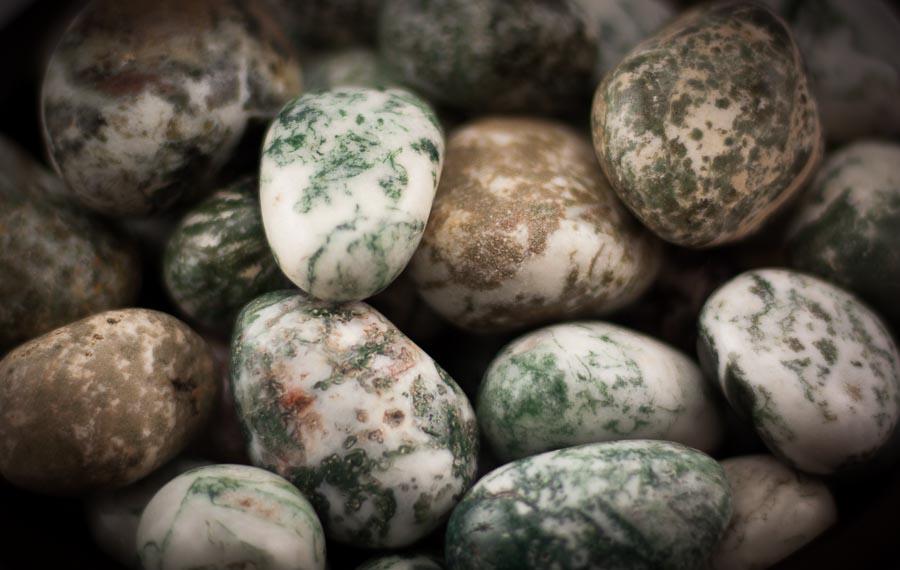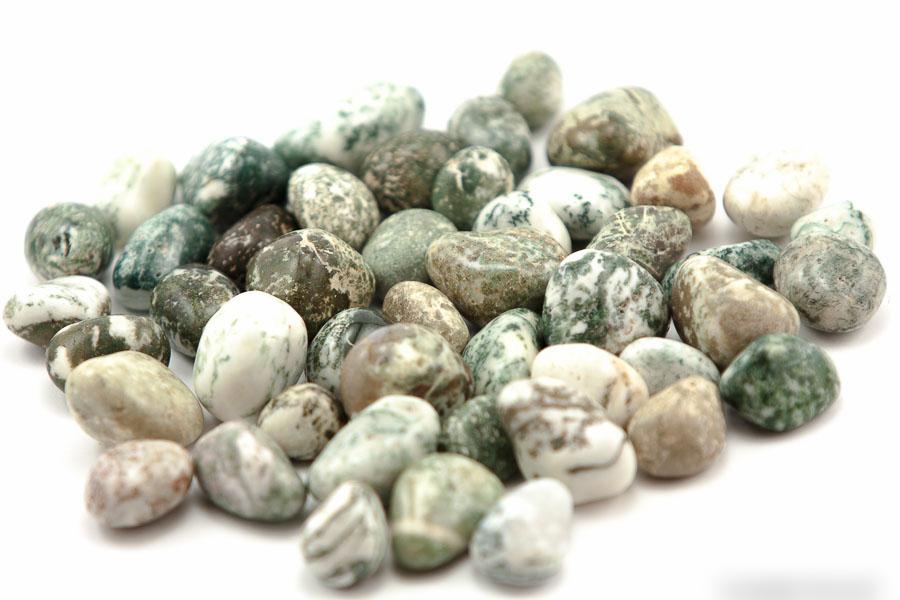You will not be allowed to compare more than 4 products at a time
View compareTree Agate Tumbled 1 lb
Tree Agate Tumbled 1 lb
Estimate delivery times:5-8 days.
Flat Rate Shipping and FREE Shipping on orders more than $100.
About This Product
Tree Agate – The Stone of Earth’s Patience and Natural Abundance
Tree Agate is a form of dendritic agate known for its striking appearance and soothing presence. Its base color ranges from milky white to creamy beige, serving as a natural canvas for deep green, moss-like inclusions that sprawl in tree-branch or fern patterns. Each stone is uniquely marked – as if tiny forests or delicate ferns have been forever sealed within the smooth chalcedony surface. The texture is generally waxy and cool to the touch, grounding and earthy, inviting a sense of calm when held. In a quiet, poetic way, Tree Agate carries the tranquil vibe of a sun-dappled woodland, making it as visually captivating as it is spiritually comforting.
Historical and Cultural Background
Ancient Reverence: Treasured since antiquity, agates (including Tree Agate) appear in some of the earliest legends and lapidary texts. In ancient Mesopotamia, the Sumerians believed that wearing agate bestowed favor from the gods, so Tree Agate was often fashioned into protective amulets and seals. In India, it was likewise used as a talisman for serenity and safeguarding, carried to attract good fortune and ward off negativity. This stone’s connection to nature made it sacred in cultures that lived close to the land – it symbolized the fertile, life-giving aspects of the earth that early civilizations sought to harness.
Agriculture & Nature Spirits: Tree Agate has long been associated with agriculture and the spirits of nature. In agrarian communities (such as ancient Greece), farmers would bury Tree Agate in their fields or hang it in fruit trees to encourage a bountiful harvest, believing the stone’s earth energy would nurture the crops. The Greeks even linked it to Dryads, the tree nymphs of myth, viewing the stone as a bridge to these protective nature spirits. Such practices reflect a broader theme: Tree Agate was seen as a fertility charm for both land and people, promoting growth and abundance. Across various cultures, pieces of Tree Agate have been worn or carried as protective amulets, thought to shield the bearer (and their harvests) with the enduring, stable energy of the natural world.
Metaphysical Symbolism
Tree Agate carries rich symbolism in the metaphysical realm, often celebrated as a stone of balance, growth, and inner peace. Its gentle yet steady vibrations are said to connect one deeply to the natural world, fostering patience and a wholesome sense of stability. Many crystal healers refer to Tree Agate as the Stone of Plenitude, reflecting its reputed ability to attract abundance and soothe the soul. Key metaphysical qualities attributed to Tree Agate include:
-
Grounding & Stability: Aligns strongly with the root chakra, helping to center and ground one’s energy. Tree Agate’s energy imparts a sense of security and resilience, making you feel “rooted” like an old tree. It stabilizes erratic emotions and promotes balance during stressful times.
-
Abundance & Fertility: Often nicknamed the “Stone of Plentitude,” it symbolizes prosperity and growth. This stone is believed to attract abundance in all forms – from financial success to plentiful harvests – and was historically used by farmers to ensure fertile fields and healthy livestock. Its green dendrites, reminiscent of sprouting plants, mirror the idea of new growth and fertile energy in one’s life.
-
Patience & Inner Peace: Tree Agate exudes a calming, nurturing vibration that soothes the nerves and encourages patience. It helps dissolve tension, promoting a mindset of quiet perseverance and inner tranquility. Many find that it brings a deep sense of inner peace, allowing them to remain composed and optimistic amid life’s challenges. This patient energy teaches the value of slow, steady growth – much like the gradual branching of a tree.
-
Connection to Nature: With its forest-like imagery, Tree Agate is deeply connected to nature and earth energy. It is said to enhance one’s attunement to the natural world, helping you feel the presence of nature spirits and devas in your surroundings. Meditating with Tree Agate can foster a profound spiritual connection to plants, trees, and the heartbeat of Mother Earth, inspiring harmony with the environment and a refreshed appreciation for the outdoors.
-
Heart & Root Chakra Harmony: Uniquely, Tree Agate resonates with both the heart chakra and the root chakra. By uniting these energy centers, it bridges emotional well-being with physical grounding. It opens the heart chakra to feelings of love, compassion, and forgiveness (bringing gentle calm to the emotions), while simultaneously stabilizing the root chakra for strength and grounding. This dual-chakra energy fosters overall wholeness — nurturing love and empathy (green energy of the heart) rooted in a secure foundation (white/earth energy of the root).
Decorative and Luxury Appeal
Natural Décor: Beyond its spiritual aspects, Tree Agate is prized as a beautiful decorative gemstone. Collectors and interior designers alike appreciate how each piece of Tree Agate brings a touch of the outdoors inside. It’s common to find tumbled stones or palm stones of Tree Agate displayed in bowls or on shelves – their silky polish and marbled green patterns make for elegant, earth-toned accents. A handful of Tree Agate pebbles on a coffee table or meditation altar creates a mini zen garden vibe, infusing the space with natural tranquility. Many people also incorporate Tree Agate into terrariums, potted plants, or feng shui arrangements, enhancing an earthy, grounding atmosphere in the home.
Carvings & Collectibles: Lapidary artists often sculpt Tree Agate into decorative objects that showcase its unique inclusions. Polished spheres of Tree Agate, for example, are popular among collectors – when rotated, these spheres reveal swirling green dendrites from every angle, like tiny forests encapsulated in crystal. Craftsmen also carve Tree Agate into figurines, obelisks, or bookends, utilizing the stone’s contrasting colors to highlight each piece’s natural “scene.” Placed on a mantel or desk, such items serve as conversation pieces that celebrate nature’s artistry. Because Tree Agate is relatively hard and takes a good polish, it’s used in luxury home décor items and earth-element talismans (sometimes paired with metals or wood) to create a harmonious, grounding design statement.
Jewelry Elegance: Tree Agate’s distinctive look also lends itself to jewelry and wearable art. Jewelers cut this stone into cabochons for rings and pendants, and craft beads for necklaces, bracelets, and earrings. The white-and-green contrast complements both metals and natural materials – it looks equally stunning set in sterling silver, gold, or wrapped in rustic copper wire. A Tree Agate pendant worn over the heart is not only a fashion accessory but also a personal talisman, thought to keep one’s energy calm and grounded throughout the day. Whether in a simple beaded bracelet or an ornate statement piece, Tree Agate jewelry carries an organic elegance, making it appealing to both bohemian crystal enthusiasts and those with high-end tastes. Wearing or carrying Tree Agate is like keeping a piece of a peaceful forest with you – a blend of luxury and earthiness that resonates with spiritual seekers, healers, and gemstone lovers.
Scientific Breakdown
For the scientifically minded, here is a breakdown of Tree Agate’s key mineralogical properties and identifying features:
-
Chemical Composition: SiO₂ (silicon dioxide), a variety of chalcedony (cryptocrystalline quartz). Green dendritic inclusions are usually iron or manganese oxides that entered the stone during formation.
-
Crystal System: Trigonal (hexagonal family). Tree Agate is microcrystalline quartz, meaning it has no visible crystals but a compact, granular structure.
-
Hardness: 6.5 to 7 on the Mohs scale. This hardness (comparable to most agates and quartz) makes Tree Agate durable enough for carving, polishing, and everyday jewelry wear.
-
Luster: Typically waxy to vitreous (glassy) when polished. Unpolished surfaces may appear matte or dull, but a good polish brings out a soft shine.
-
Transparency: Opaque to semi-translucent. Most Tree Agate stones are opaque due to their multitude of inclusions, though thinner slices or edges might let light through. (By contrast, Moss Agate often has higher translucency, one way to tell them apart.)
-
Cleavage & Fracture: No cleavage (it does not split along neat planes). Fracture is conchoidal – meaning it breaks with smooth, curved surfaces like bottle glass. This conchoidal fracture is a hallmark of quartz-based minerals.
-
Habit: Occurs in massive form (no distinct crystal shape), often found as rounded nodules or pebble-like masses. Agates including Tree Agate commonly form in volcanic rock cavities or geodes, filling the space with layerless chalcedony.
-
Common Inclusions: Characteristic green dendrites (branching inclusions) of manganese or iron minerals. These dendritic patterns crystallize in fractal-like shapes resembling trees or ferns. Notably, Tree Agate typically lacks the multicolored banding of other agates, focusing instead on these tree-like inclusions.
-
Primary Sources: Mainly mined in India, Brazil, Madagascar, and the USA. India is especially known for producing large quantities of dendritic agates marketed as Tree Agate. Other notable sources include Uruguay, Mexico, and South Africa, though the stone can be found in volcanic regions worldwide.
-
Identifying Features: Opaque white to off-white chalcedony with green dendritic veining is the signature look of Tree Agate. It usually shows no concentric banding, distinguishing it from true banded agates. The inclusions tend to be forest-green (though occasionally they may appear dark brown or blackish-green) and have a dendritic, branching form. Tree Agate has a smooth, waxy luster when polished and feels cool and dense in the hand due to its quartz composition. Collectors often note that each piece looks like a miniature landscape or mossy forest scene – a reliable visual cue that you’re holding genuine Tree Agate.
Each of these traits makes Tree Agate a delight for both scientists and collectors: it is at once a geological marvel – a product of minerals and time – and a natural artwork resembling serene woodlands. Whether you’re drawn to its aesthetics, its storied past, or its grounding energy, Tree Agate stands out as a gemstone that beautifully unites the scientific and the spiritual.
Sub total:
$17.49





